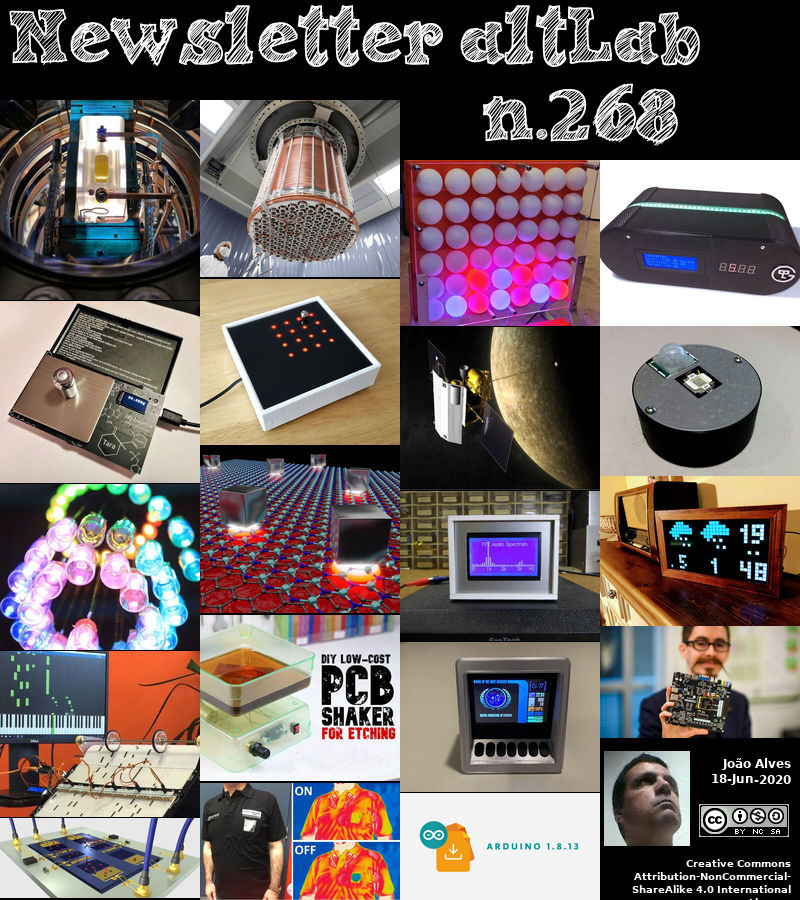2020-06-18 - Nº 268
Editorial
Esta é a Newsletter Nº 268 que se apresenta com o mesmo formato que as anteriores. Se gostar da Newsletter partilhe-a!
Todas as Newsletters encontram-se indexadas no link.
Esta Newsletter tem os seguintes tópicos:
Faz hoje anos que nascia, em 1799 o astrónomo inglês William Lassell. Ele construiu seu próprio telescópio de 24" de diâmetro e criou equipamentos movidos a vapor para polir o espelho de metal de especulo. Este telescópio foi o primeiro do seu tamanho a ser montado "equitativamente" para facilitar a observação das estrelas. Ele descobriu Triton, uma lua de Neptuno, e Ariel e Umbriel, satélites de Úrano. Mais tarde, Lassell construiu um telescópio de 48" de diâmetro com o mesmo design e transportou-o para Malta para observações com céu mais claro.
Faz também hoje anos que nascia, em 1918 o químico americano Jerome Karle. Ele partilhou o prémio Nobel de química em 1985 (com Herbert A. Hauptman) pelas "suas realizações notáveis no desenvolvimento de métodos directos para a determinação de estruturas cristalinas". O seu trabalho possibilitou a determinação de estruturas de cristal 3D, como moléculas de hormónios, vitaminas e antibióticos. Ele começou a sua carreira com um breve período em Chicago, no início da década de 1940, a trabalhar para o Projecto Manhattan, desenvolvendo a bomba atómica, e então juntou-se à equipa do Laboratório de Pesquisa Naval em 1946. Ele tornou-se o cientista chefe do Laboratório de Estrutura da Matéria. em 1968.
Faz igualmente hoje anos que nascia, em 1926 o astrónomo americano Allan Sandage. Juntamente com Thomas A. Matthews descobriu, em 1960, a primeira identificação óptica de uma fonte de rádio quase-estelar (quasar), um objecto semelhante a uma estrela que é um forte emissor de ondas de rádio. Embora fosse uma fonte estranha de emissão de rádio, sob luz visível, parecia uma estrela fraca. No entanto, este objecto emitia ondas de rádio e radiação ultravioleta mais intensas do que uma estrela típica.
Por fim, faz anos hoje que nascia, em 1932, o químico americano Dudley R. Herschbach. Ele foi pioneiro no uso de feixes moleculares para elucidar os processos de reacções químicas. Este estudo da dinâmica da reacção detalha a sequência de eventos e estados de energia dos átomos e moléculas. Pelos seus trabalhos recebeu o Prémio Nobel da química em 1986 (Juntamente com Yuan T. Lee e John C. Polanyi).
Nesta semana que passou foi lançada a versão 1.8.13 do Arduino IDE. De entre as inúmeras correcções de erros, esta versão introduz uma melhoria significativa na organização do menu de placas listadas no Menu "Tools".
Na Newsletter desta semana apresentamos diversas noticias, artigos científicos assim como projetos de maker.
 João Alves ([email protected])
João Alves ([email protected])
O conteúdo da Newsletter encontra-se sob a licença  Creative Commons Attribution-NonCommercial-ShareAlike 4.0 International License.
Creative Commons Attribution-NonCommercial-ShareAlike 4.0 International License.
Novidades da Semana

Arduino 1.8.13 has been released
"Today, we are excited to announce the arrival of the Arduino IDE 1.8.13. Significant improvements include fixing the crash on Mac OS X with multiple monitor setups and resolving the recent package_index.json issue without other user intervention. You will also notice that the boards listed in the “Tools” menu are now grouped by platform, making it easier to navigate when you have multiple boards loaded. " [...]
Outras Notícias

NXP Selects TSMC 5nm Process for Next Generation High Performance Automotive Platform
"NXP Semiconductors N.V. (NASDAQ: NXPI) and TSMC (TWSE: 2330, NYSE: TSM) today announced a collaboration agreement to adopt TSMC’s 5-nanometer (5nm) technology for NXP’s next generation, high-performance automotive platform. This collaboration combines NXP’s automotive design expertise with TSMC’s industry-leading 5nm technology to further drive the transformation of automobiles into powerful computing systems for the road. Building upon multiple successful 16nm designs, TSMC and NXP are expanding their collaboration to create a System-on-Chip (SoC) platform in 5nm to deliver the next generation of automotive processors. Using TSMC’s 5nm process, NXP’s offerings will address a wide variety of functions and workloads, such as connected cockpits, high-performance domain controllers, autonomous driving, advanced networking, hybrid propulsion control and integrated chassis management. TSMC’s 5nm technology is currently the world’s most advanced process in volume production. NXP will adopt N5P, an enhanced version of TSMC’s 5nm technology, which provides about 20 percent faster speed or about 40 percent power reduction compared to the preceding 7nm generation, and is supported by the industry’s most comprehensive design ecosystem." [...]
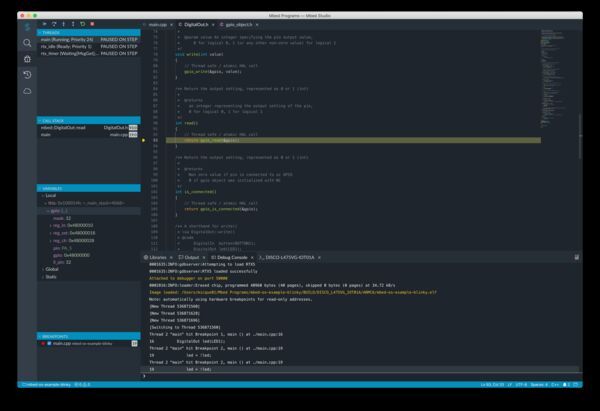
Mbed Studio 1.0 released
"I’m pleased to announce that the 1.0 release of Mbed Studio is now available for macOS, Windows and Linux. You can download Mbed Studio from here: https://os.mbed.com/studio With the number of developers with an Mbed account growing by 20% since the initial release last year, some of you might be new to Mbed Studio. Here is a summary of the features and some background: New: Custom target management New: Keil uVision exporter New: Better source control workflows for git and mbed.com New: Completely overhauled documentation New: Mbed OS 6 support with examples New: Checkout progress for libraries added to the libraries panel Full set of tools dependencies (git, hg, Arm Compiler 6, gdb, pyOCD, Mbed CLI, GreenTea, clangd etc) inluded with the product along with terminal access from inside Mbed Studio Powerful Monaco editor including C++ intellisense for your development board and a source code minimap Integration with Pelion Device Management Services Preferences support for the editor and IDE Workspace management and search capabilities Support for Linux (Ubuntu 18 & 20) Serial output (automatically launched when you connect a board) Step debugging Custom build profile support Background We started on our journey toward this version of Mbed Studio around two years ago with a goal to make it easier for you to develop embedded and IoT products with Mbed OS, both in desktop and browser environments. We have been releasing updates and improvements steadily since 2019, with your bug reports and suggestions guiding us and helping us to prioritize where we focus. By providing the full set of software tool dependencies required to work with Mbed OS in a single installer, Mbed Studio dramatically improves the first time set up of an Mbed environment. Our choice to work with the Eclipse Theia IDE framework has meant we have a codebase that includes the powerful Microsoft Monaco editor and a platform which can be deployed to the browser in future." [...]

Quantum Machines announces QUA, its universal language for quantum computing
"It’s a busy week in the world of quantum computing, and today Tel Aviv-based Quantum Machines, a startup that is building a software and hardware stack for controlling and operating quantum computers, announced the launch of QUA, a new language that it calls the first “standard universal language for quantum computers.” Quantum Machines CEO Itamar Sivan likened QUA to developments like Intel’s x86 and Nvidia’s CUDA, both of which provide the low-level tools for developers to get the most out of their hardware. Quantum Machine’s own control hardware is essentially agnostic with regards to the underlying quantum technology that its customers want to use. The idea here is that if the company manages to make its own hardware the standard for controlling these systems, then its language will — almost by default — become the standard as well. And while it’s a “universal” language in the technical sense, it is — at least for now — meant to run on Quantum Machine’s own Quantum Orchestration Platform, which it announced earlier this year. “QUA is basically the language of the Quantum Orchestration Platform,” Sivan told me. “But beyond that, QUA is what we believe the first candidate to become what we define as the ‘quantum computing software abstraction layer.’ ” He argued that we are now at the right stage for the development of this layer because the underlying hardware has reached a matureness and because these systems are now fully programmable." [...]

Rocket Motors for First NASA Artemis Moon Mission Arrive at Spaceport
"The rocket booster segments that will help power NASA’s first Artemis flight test mission around the Moon arrived at the agency’s Kennedy Space Center in Florida on Monday for launch preparations. All 10 segments for the inaugural flight of NASA’s first Space Launch System (SLS) rocket and Orion spacecraft were shipped by train from Promontory, Utah. The 10-day, cross-country journey is an important milestone toward the first launch for NASA’s Artemis program. “The arrival of the booster segments at Kennedy is just the beginning of the SLS rocket’s journey to the pad and onward to send the Orion spacecraft to the Moon,“ said NASA Administrator Jim Bridenstine. “Artemis I will pave the way toward landing the first woman and the next man on the surface of the Moon in 2024 and expanding human exploration to Mars.” Each rocket booster has individual motor segments, located between the forward assemblies and aft skirts, making up the largest single component of the entire booster. The two SLS rocket boosters, four RS-25 engines, and core stage, produce a combined total of more than 8.8 million pounds of thrust power during launch." [...]
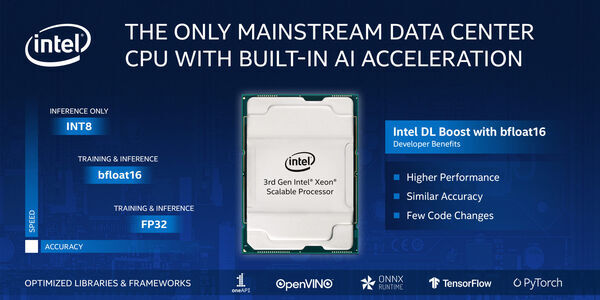
Intel Announces Unmatched AI and Analytics Platform with New Processor, Memory, Storage and FPGA Solutions
"Intel today introduced its 3rd Gen Intel® Xeon® Scalable processors and additions to its hardware and software AI portfolio, enabling customers to accelerate the development and use of artificial intelligence (AI) and analytics workloads running in data center, network and intelligent-edge environments. As the industry’s first mainstream server processor with built-in bfloat16 support, Intel’s new 3rd Gen Xeon Scalable processors makes AI inference and training more widely deployable on general-purpose CPUs for applications that include image classification, recommendation engines, speech recognition and language modeling. “The ability to rapidly deploy AI and data analytics is essential for today’s businesses. We remain committed to enhancing built-in AI acceleration and software optimizations within the processor that powers the world’s data center and edge solutions, as well as delivering an unmatched silicon foundation to unleash insight from data.” –Lisa Spelman, Intel corporate vice president and general manager, Xeon and Memory Group Why It’s Important: AI and analytics open new opportunities for customers across a broad range of industries, including finance, healthcare, industrial, telecom and transportation. IDC predicts that by 2021, 75% of commercial enterprise apps will use AI1. And by 2025, IDC estimates that roughly a quarter of all data generated will be created in real time, with various internet of things (IoT) devices creating 95% of that volume growth2." [...]

STMicroelectronics Accelerates Creation of Advanced High-Efficiency Power Solutions with STM32 Digital-Power Ecosystem
"STMicroelectronics (NYSE: STM), a global semiconductor leader serving customers across the spectrum of electronics applications, has launched a web-based ecosystem to help designers build digital-power solutions using STM32 microcontrollers (MCUs). Digital power supplies are an emerging class of devices able to optimize energy efficiency and capture rich data for diagnostics and safety. Digital control also lets designers increase power density to realize size and weight savings that are important in data centers, 5G infrastructure, smart lighting, and mobile devices. The STM32 D-Power website consolidates developer resources that include the all-in-one STM32 digital-power Discovery Kits, embedded software components, software tools created by ST Authorized Partner Biricha Digital, and dedicated power-supply boards that demonstrate various designs and power ratings. Documentation, videos, and guides cater to beginners up to expert power-supply designers, and a four-day hands-on workshop created by Biricha shows how to build digital power supplies using STM32 MCUs. The ecosystem is scaled to support three levels of STM32 microcontrollers that combine the benefits of industry-standard Arm® Cortex®-M cores with integrated features optimized for digital-power applications." [...]
Ciência e Tecnologia

A spreadable way to stabilise solid state batteries
"Solid state batteries are of great interest to the electric vehicle industry. Scientists at Chalmers and Xi'an Jiaotong University, China now present a new way of taking this promising concept closer to large-scale application. An interlayer, made of a spreadable, ‘butter-like’ material helps improve the current density tenfold, while also increasing performance and safety. "This interlayer makes the battery cell significantly more stable, and therefore able to withstand much higher current density. What is also important is that it is very easy to apply the soft mass onto the lithium metal anode in the battery – like spreading butter on a sandwich,” says researcher Shizhao Xiong at the Department of Physics at Chalmers. Alongside Chalmers Professor Aleksandar Matic and Professor Song's research group in Xi'an, Shizhao Xiong has been working for a long time on crafting a suitable interlayer to stabilise the interface for solid state battery. The new results were recently presented in the prestigious scientific journal Advanced Functional Materials." [...]

The first intuitive programming language for quantum computers
"Several technical advances have been achieved recently in the pursuit of powerful quantum computers. Now, Computer scientists from ETH Zurich have made an important breakthrough in the field of programming languages: their quantum language is the first of its kind that is as elegant, simple and safe as classical computer languages. Programming quantum computers is becoming easier: computer scientists at ETH Zurich have designed the first programming language that can be used to program quantum computers as simply, reliably and safely as classical computers. “Programming quantum computers is still a challenge for researchers,” says Martin Vechev, computer science professor in ETH’s Secure, Reliable and Intelligent Systems Lab (SRI), “which is why I’m so excited that we can now continue ETH Zurich’s tradition in the development of quantum computers and programming languages.” He adds: “Our quantum programming language Silq allows programmers to utilize the potential of quantum computers better than with existing languages, because the code is more compact, faster, more intuitive and easier to understand for programmers.” This week, Vechev will introduce Silq to other experts in the field at PLDI 2020, a conference for programming languages. To facilitate discussion, adoption and further development, he and his team have also released Silq on its own website (silq.ethz.ch). Quantum computing has been seeing increased attention over the last decade, since these computers, which function according to the principles of quantum physics, have enormous potential." [...]
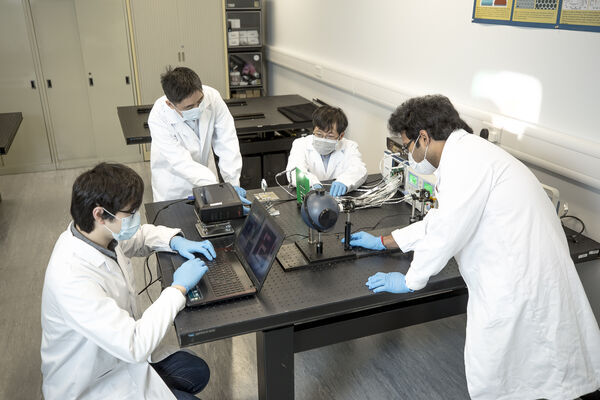
HKUST Scientists Develop World's First Spherical Artificial Eye with 3D Retina
"An international team led by scientists at the Hong Kong University of Science and Technology (HKUST) has recently developed the world’s first 3D artificial eye with capabilities better than existing bionic eyes and in some cases, even exceed those of the human eyes, bringing vision to humanoid robots and new hope to patients with visual impairment. Scientists have spent decades trying to replicate the structure and clarity of a biological eye, but vision provided by existing prosthetic eyes – largely in the form of spectacles attached with external cables, are still in poor resolution with 2D flat image sensors. The Electrochemical Eye (EC-Eye) developed at HKUST, however, not only replicates the structure of a natural eye for the first time, but may actually offer sharper vision than a human eye in the future, with extra functions such as the ability to detect infrared radiation in darkness. The key feature allowing such breakthroughs is a 3D artificial retina - made of an array of nanowire light sensors which mimic the photoreceptors in human retinas. Developed by Prof. FAN Zhiyong and Dr. GU Leilei from the Department of Electronic and Computer Engineering at HKUST, the team connected the nanowire light sensors to a bundle of liquid-metal wires serving as nerves behind the man-made hemispherical retina during the experiment, and successfully replicated the visual signal transmission to reflect what the eye sees onto the computer screen." [...]

Three Research Groups, Two Kinds of Electronic Properties, One Material
"Combining materials science, experimental and theoretical physics, a long-term study paves the way to new designed materials with multiple electrical functionalities This it is the story of a unique material – made of a single compound, it conducts electrons in different ways on its different surfaces and doesn’t conduct at all in its middle. It is also the story of three research groups – two at the Weizmann Institute of Science and one in Germany, and the unique bond that has formed between them. The material belongs to a group of materials discovered a decade and a half ago known as topological insulators. These materials are conducting on their surfaces and insulating in their inside “bulk.” But the two properties are inseparable: Cut the material, and the new surface will be conducting, the bulk will remain insulating. Some five years ago, Dr. Nurit Avraham was a staff scientist in the new group of Dr. Haim Beidenkopf of the Institute’s Condensed Matter Physics Department. Around that time, she and Beidenkopf met Prof. Binghai Yan on Yan’s first scientific visit to the Weizmann Institute." [...]

Sound Waves Transport Droplets for Rewritable Lab-on-a-Chip Devices
"Vibrating transducers create tunnels in a thin layer of oil to transport droplets across a chip without leaving a trace behind Engineers at Duke University have demonstrated a versatile microfluidic lab-on-a-chip that uses sound waves to create tunnels in oil to touchlessly manipulate and transport droplets. The technology could form the basis of a small-scale, programmable, rewritable biomedical chip that is completely reusable to enable on-site diagnostics or laboratory research. The results appear online on June 10 in the journal Science Advances. “Our new system achieves rewritable routing, sorting and gating of droplets with minimal external control, which are essential functions for the digital logic control of droplets,” said Tony Jun Huang, the William Bevan Distinguished Professor of Mechanical Engineering and Materials Science at Duke. “And we achieve it with less energy and a simpler setup that can control more droplets simultaneously than previous systems.” Automated fluid handling has driven the development of many scientific fields such as clinical diagnostics and large-scale compound screening. While ubiquitous in the modern biomedical research and pharmaceutical industries, these systems are bulky, expensive and do not handle small volumes of liquids well." [...]
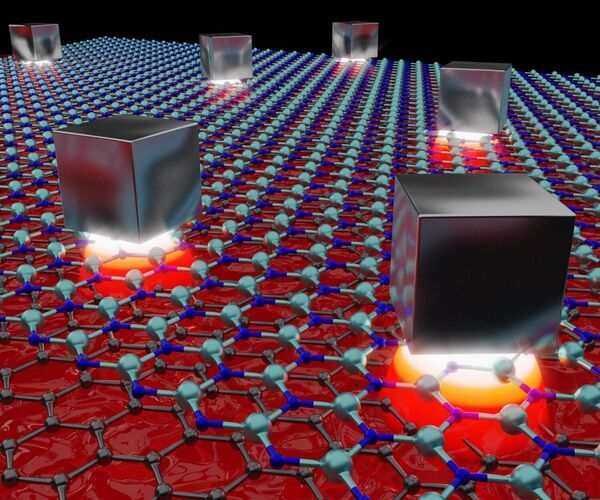
Smallest cavity for light realized by graphene plasmons
"In a study in Science, researchers from ICFO, MIT, Duke, University of Paris-Saclay, and Universidad do Minho report on the smallest cavities ever realized for infrared light by using graphene and metallic cubes of nanometer sizes. Miniaturization has enabled so many unfathomable dreams. Shrinking down electronic circuits has allowed us to access technology like smartphones, health watches, medical probes, nano-satellites, unthinkable a couple decades ago. Just imagine that in the course of 60 years, the transistor has gone from being the size of your hand palm to 14 nanometers in dimension, 1000 times smaller than the diameter of a hair. Miniaturization has pushed technology to a new era of optical circuitry. But, in parallel, it has also triggered new challenges and obstacles to overcome, for example, on how to deal with controlling and guiding light at the nanometer scale." [...]

A breakthrough in developing multi-watt terahertz lasers
"Researchers at Lehigh's Center for Photonics and Nanoelectronics are using a new phase-locking technique to achieve record-high output power for terahertz lasers and reported the highest radiative efficiency for any single-wavelength semiconductor quantum cascade laser (QCL). Terahertz lasers could soon have their moment. Emitting radiation that sits somewhere between microwaves and infrared light along the electromagnetic spectrum, terahertz lasers have been the focus of intense study due to their ability to penetrate common packaging materials such as plastics, fabrics, and cardboard and be used for identification and detection of various chemicals and biomolecular species, and even for imaging of some types of biological tissue without causing damage. Fulfilling terahertz lasers’ potential for use hinges on improving their intensity and brightness, achieved by enhancing power output and beam quality. Sushil Kumar, associate professor in Lehigh's Department of Electrical and Computer Engineering, and his research team are working at the forefront of terahertz semiconductor 'quantum-cascade' laser (QCL) technology. In 2018, Kumar, who is also affiliated with Lehigh’s Center for Photonics and Nanoelectronics (CPN) reported on a simple yet effective technique to enhance the power output of single-mode lasers based on a new type of “distributed-feedback” mechanism." [...]

First space-based measurement of neutron lifetime
"Our researchers have helped to find a way of measuring neutron lifetime from space for the first time. The discovery could teach us more about the early universe as knowing the lifetime of neutrons is key to understanding the formation of elements after the Big Bang 13.8 billion years ago. Scientists used data from NASA’s MErcury Surface, Space ENvironment, GEochemistry, and Ranging (MESSENGER) spacecraft. Neutron particles As MESSENGER flew over Venus and Mercury it measured the rates at which neutron particles were leaking out from the two planets. The number of neutrons detected depended on the time it took them to fly up to the spacecraft relative to the neutron lifetime, giving the scientists a way of calculating how long the subatomic particles could survive. Neutrons are normally found in the nucleus of an atom but quickly disintegrate into electrons and protons when outside the atom." [...]
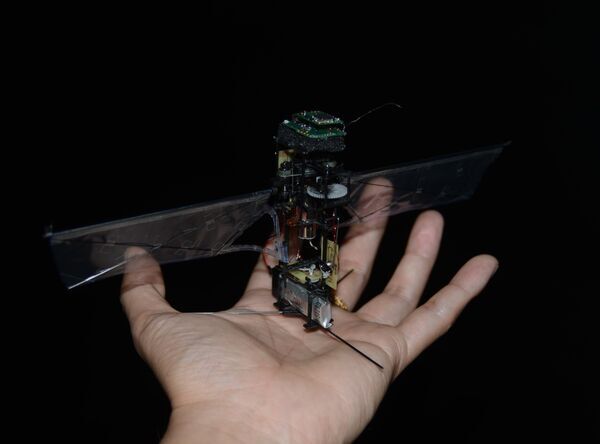
KUBeetle-S: An insect-inspired robot that can fly for up to 9 minutes
"Researchers at Konkuk University in South Korea recently created KUBeetle-S, a flying robot inspired by a species of horned beetle called Allomyrina dichotoma, which is among the largest insects on the planet. Allomyrina dichtoma weighs approximately 5 to 10 g and has a wing loading of 40 N/m2, which is remarkably high when compared to average insect wing loadings (typically around 8 N/m2). "To mimic the beetle's flight, we first developed a flapping-wing mechanism that can create a large flapping angle and produce lift to compensate weight of the KUBeetle-S, just like the horned beetle it draws inspiration from," Prof. Hoon Cheol Park, one of the researchers who carried out the recent study, told TechXplore. "Since the KUBeetle-S is not equipped with control surfaces at the tail, unlike a conventional flyer, its flapping wings must be able to produce control moments only by changing their wing kinematics in the middle of the flapping motion." The control moment generator that Prof. Park and his colleagues installed within KUBeetle-S can change the robot's wing stroke plane to the right, left, front and back, ultimately enabling the redirection of its vertical lift as desired and simultaneously generating control moment. This generator is mechanically integrated with lightweight servo motors and can also be electronically controlled via a control board and a feedback control system based on an algorithm developed by the researchers." [...]
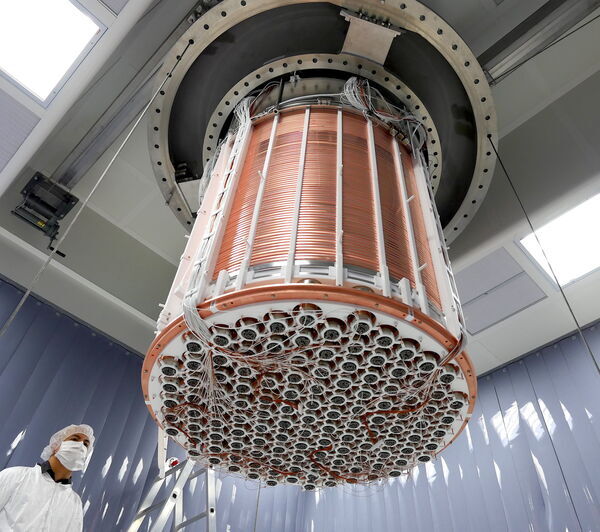
A Startling Excess of Particle Detections by the XENON1T Could Point to New Physics
"A strange thing happened while running the most sensitive dark matter detector built to date, known as XENON1T. Having painstakingly accounted for all known sources of particles that could trigger the exquisitely sensitive apparatus, researchers confidently expected 232 triggering events—no more, no less. Yet XENON1T racked up a surprising excess of 285 particle detections. Researchers are cautiously elated by the findings, announced earlier this week, which could point to brand-new physics. To be clear, the eyebrow-raising excess does not match the signal for dark matter—XENON1T's primary quarry, a theoretical substance that constitutes as much as 85 percent of the matter in the cosmos. But on the short list of three conceivable candidates behind the excess, two would represent breakthroughs of their own in physics." [...]

Physicists at the University of Halle develop a new theory for Bose-Einstein condensates
"Bose-Einstein condensates are often described as the fifth state of matter: At extremely low temperatures, gas atoms behave like a single particle. The exact properties of these systems are notoriously difficult to study. In the journal "Physical Review Letters", physicists from Martin Luther University Halle-Wittenberg (MLU) and Ludwig Maximilian University Munich have proposed a new theory to describe these quantum systems more effectively and comprehensively. Research into the exotic state of matter dates back to Albert Einstein, who predicted the theoretical existence of Bose-Einstein condensates in 1924. "Many attempts were made to prove their existence experimentally," says Dr Carlos Benavides-Riveros from the Institute of Physics at MLU. Finally, in 1995, researchers in the U.S. succeeded in producing the condensates in experiments." [...]
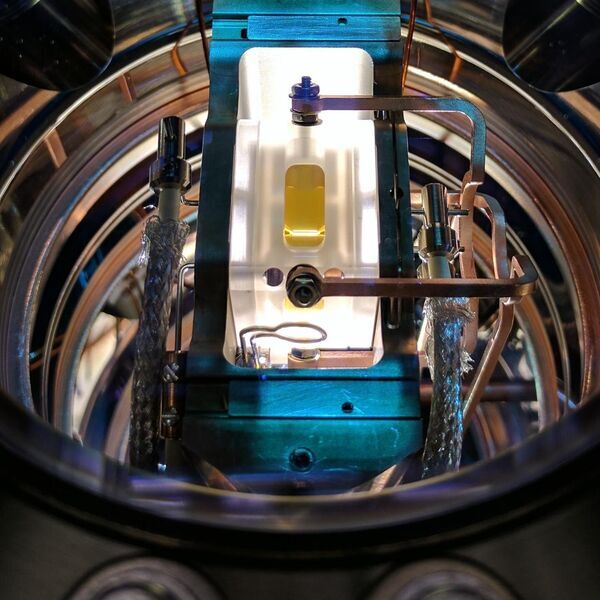
Borrowing from robotics, scientists automate mapping of quantum systems
"Understanding hardware errors helps stabilise quantum tech PhD candidate Riddhi Gupta has taken an algorithm used in autonomous vehicles and adapted it to help characterise and stabilise quantum technology. Scientists at the University of Sydney have adapted techniques from autonomous vehicles and robotics to efficiently assess the performance of quantum devices, an important process to help stabilise the emerging technologies. The innovative approach has been shown experimentally to outperform simplistic characterisation of these environments by a factor of three, with a much higher result for more complex simulated environments. “Using this approach, we can map the ‘noise’ causing performance variations across quantum devices at least three times as quickly as a brute-force approach,” said lead author Riddhi Gupta, a PhD student in the School of Physics. “Rapidly assessing the noise environment can help us improve the overall stability of quantum devices.” The research has been published in Nature partner journal Quantum Information. Quantum computing is still in its early stages of development yet promises to revolutionise technology by solving problems beyond the scope of classical computing." [...]

Quantum material research connecting physicists in Hong Kong, Beijing and Shanghai facilitates discovery of better materials that benefit our society
"A joint research team from the University of Hong Kong (HKU), Institute of Physics at Chinese Academy of Science, Songshan Lake Materials Laboratory, Beihang University in Beijing and Fudan University in Shanghai, has provided a successful example of modern era quantum material research. By means of the state-of-art quantum many-body simulations, performed on the world’s fastest supercomputers (Tianhe-I and Tianhe-III protype at National Supercomputer Center in Tianjin and Tianhe-II at National Supercomputer Center in Guangzhou), they achieved accurate model calculations for a rare-earth magnet TmMgGaO4 (TMGO). They found that the material, under the correct temperature regime, could realise the the long-sought-after two-dimensional topological Kosterlitz-Thouless (KT) phase, which completed the pursuit of identifying the KT physics in quantum magnetic materials for half a century. The research work has been published in Nature Communications. Quantum materials are becoming the cornerstone of the continuous prosperity of human society. From the next-generation AI computing chips that go beyond Moore’s law (the law is the observation that the number of transistors in a dense integrated circuit doubles about every two years, our PCs and smartphones are all based on the success of it." [...]
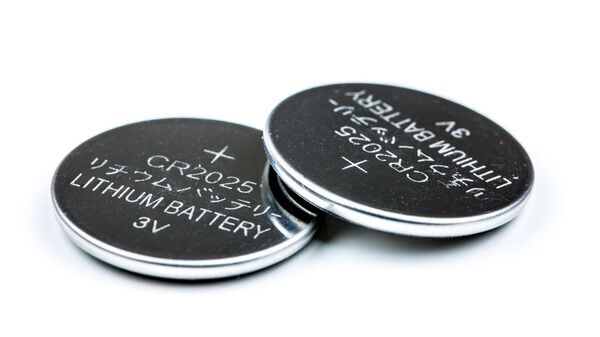
Graphene with sodium could make better batteries
"Graphene doped with sodium can be a key player in making cheap batteries and spintronic devices, EPFL scientists discover. “Lithium is becoming a critical material as it is used extensively in cell-phones and car batteries, while, in principle, sodium could be a much cheaper, more abundant alternative,” says Ferenc Simon, a visiting scientist in the group of László Forró at EPFL. “This motivated our quest for a new battery architecture: sodium doped graphene.” Graphite doped with lithium atoms, is one of the most common anode material in batteries, and won the 2019 Nobel prize in Chemistry. But the increasing use of lithium can lead to a shortage. On the other hand, sodium is the 6th most abundant element on Earth, while lithium is just 25th. Plus, sodium is available from various sources including rock salt or sea water." [...]
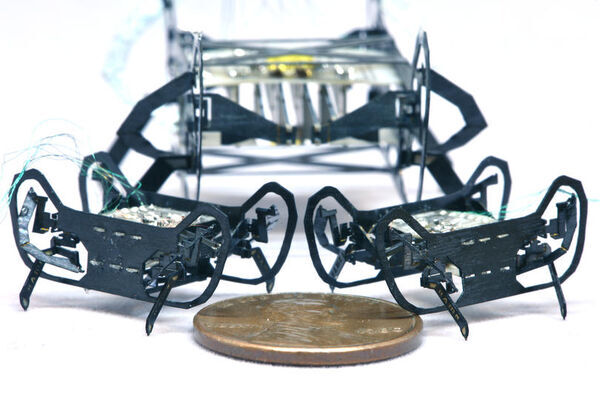
Next-generation cockroach-inspired robot is small but mighty
"This itsy-bitsy robot can’t climb up the waterspout yet but it can run, jump, carry heavy payloads and turn on a dime. Dubbed HAMR-JR, this microrobot developed by researchers at the Harvard John A. Paulson School of Engineering and Applied Sciences (SEAS) and the Harvard Wyss Institute for Biologically Inspired Engineering, is a half-scale version of the cockroach-inspired Harvard Ambulatory Microrobot or HAMR. About the size of a penny, HAMR-JR can perform almost all of the feats of its larger-scale predecessor, making it one of the most dexterous microrobots to date. “Most robots at this scale are pretty simple and only demonstrate basic mobility,” said Kaushik Jayaram, a former postdoctoral fellow at SEAS and Wyss and first author of the paper. “We have shown that you don’t have to compromise dexterity or control for size.” Jayaram is currently an Assistant Professor at the University of Colorado, Boulder. The research was presented virtually at the International Conference on Robotics and Automation (ICRA 2020) this week." [...]
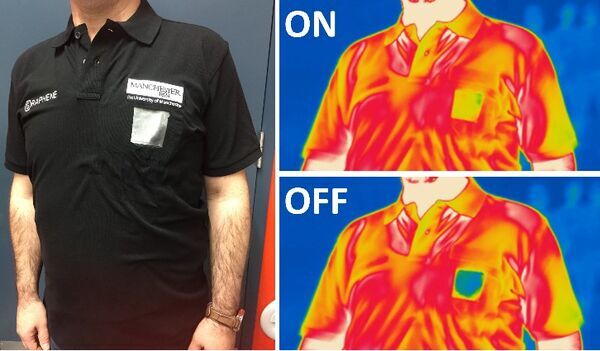
Graphene smart textiles developed for heat adaptive clothing
"ew research on the two-dimensional (2D) material graphene has allowed researchers to create smart adaptive clothing which can lower the body temperature of the wearer in hot climates. A team of scientists from The University of Manchester’s National Graphene Institute have created a prototype garment to demonstrate dynamic thermal radiation control within a piece of clothing by utilising the remarkable thermal properties and flexibility of graphene. The development also opens the door to new applications such as, interactive infrared displays and covert infrared communication on textiles. The human body radiates energy in the form of electromagnetic waves in the infrared spectrum (known as blackbody radiation). In a hot climate it is desirable to make use the full extent of the infrared radiation to lower the body temperature which can be achieved by using infrared-transparent textiles. As for the opposite case, infrared-blocking covers are ideal to minimise the energy loss from the body." [...]
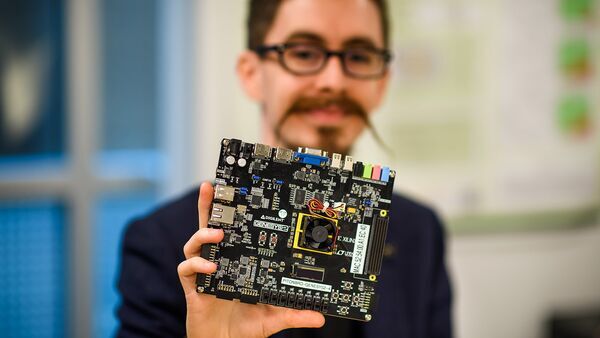
Design allows computer engineers to mix systems to boost performance
"Computers are renowned for flexibility, running everything from game consoles to stock exchanges. But at the level of computation, most computers rely on arrays of identical processors called cores. Now, a team at Princeton University has built a hardware platform that allows different kinds of computer cores to fit together, allowing designers to customize systems in new ways. The goal is to create new systems that parcel out tasks among specialized cores, increasing efficiency and speed. On top of multi-core collaboration, even more gains are achievable when cores needn't all rely on the same basic programming code that tells a core how to handle its processing jobs. Designers call this basic code an Instruction Set Architecture (ISA)." [...]

Researchers create a photographic film of a molecular switch
"Following the motion of a light-responsive molecule / Study in "The Journal of Physical Chemistry Letters" Molecular switches – they are the molecular counterparts of electrical switches and play an important role in many processes in nature. Such molecules can reversibly interconvert between two or more states and thereby control molecular processes. In living organisms, for example, they play a role in muscle contraction but also our visual perception is based on the dynamics of a molecular switch in the eye. Scientists are working intensively to develop novel molecular components that enable switching between different states, so that molecular processes can be specifically controlled. A European research team led by nanotechnologist Dr. Saeed Amirjalayer from the University of Münster now gained a deeper insight into the processes of a molecular switch: Using molecular dynamics simulations, the scientists produced a photographic film at the atomic level and thus tracked the motion of a molecular building block. The result was a light-controlled "pedalo-type motion", going forward and backward." [...]
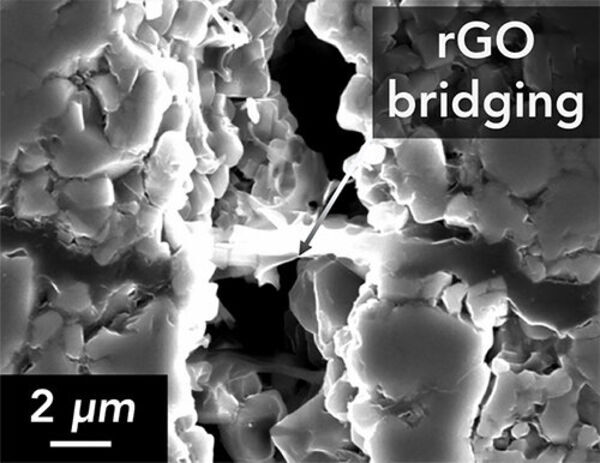
Researchers make next-generation, high-toughness battery component
"By combining a ceramic material with graphene, Brown University engineers have made what they say is the toughest solid electrolyte built to date. A team of Brown University researchers has found a way to double the toughness of a ceramic material used to make solid-state lithium ion batteries. The strategy, described in the journal Matter, could be useful in bringing solid-state batteries to the mass market. “There’s huge interest in replacing the liquid electrolytes in current batteries with ceramic materials because they’re safer and can provide higher energy density,” said Christos Athanasiou, a postdoctoral researcher in Brown’s School of Engineering and lead author of the research. “So far, research on solid electrolytes has focused on optimizing their chemical properties. With this work, we’re focusing on the mechanical properties, in the hope of making them safer and more practical for widespread use.” The electrolyte is the barrier between a battery’s cathode and anode through which lithium ions flow during charging or discharging." [...]
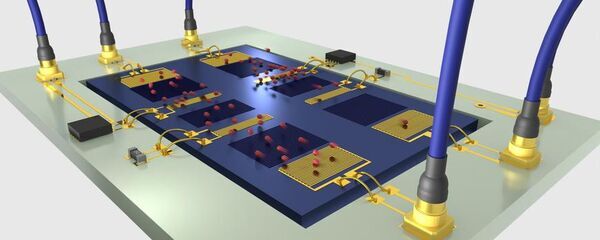
A one-way street for acoustic waves
"Device could improve quantum and classical communications If you can hear your neighbors through a shared wall, you better believe they can hear you too. This has nothing to do with your annunciation and everything to do with a fundamental property of how waves — be they acoustic, light or electric — move through materials. Most media are reciprocal, meaning if a wave can travel from point A to point B, it can also travel from point B to point A at identical frequencies and amplitudes. This may be advantageous for eavesdroppers, but reciprocity causes all kinds of interference and crosstalk in signal processing. As communications technology gets smaller — and waves get confined in smaller and smaller spaces — devices that can break a signal’s symmetry are increasingly more important. However, most of today’s so-called non-reciprocal acoustic devices are too bulky and difficult to integrate onto chips." [...]
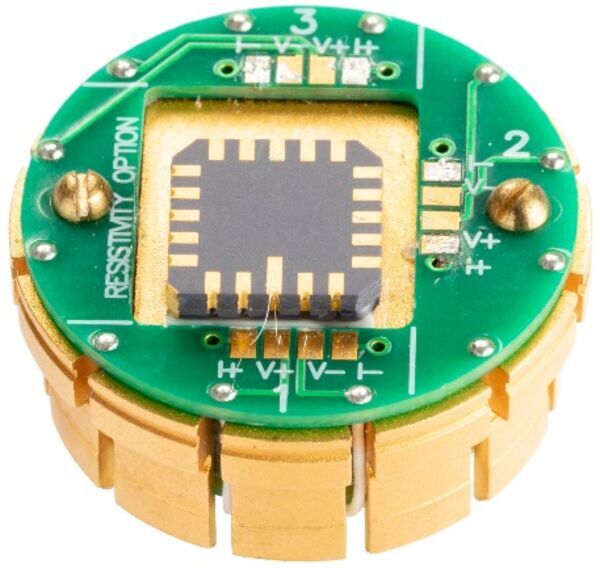
CERN trials graphene for magnetic measurements
"First isolated in 2004 by physicists at the University of Manchester using pieces of sticky tape and a graphite block, the one-atom-thick carbon allotrope graphene has been touted as a wonder material on account of its exceptional electrical, thermal and physical properties. Turning these properties into scalable commercial devices has proved challenging, however, which makes a recently agreed collaboration between CERN and UK firm Paragraf on graphene-based Hall-probe sensors especially novel. There is probably no other facility in the world to be able to confirm this, so the project has been a big win on both sides Ellie Galanis With particle accelerators requiring large numbers of normal and superconducting magnets, high-precision and reliable magnetic measurements are essential. While the workhorse for these measurements is the rotating-coil magnetometer with a resolution limit of the order of 10–8 Vs, the most important tool for local field mapping is the Hall probe, which passes electrical current proportional to the field strength when the sensor is perpendicular to a magnetic field. However, measurement uncertainties in the 10–4 range required for determining field multipoles are difficult to obtain, even with the state-of-the-art devices. False signals caused by non-perpendicular field components in the three-dimensional sensing region of existing Hall probes can increase the measurement uncertainty, requiring complex and time-consuming calibration and processing to separate true signals from systematic errors." [...]

Physicists Document Method to Improve Magnetoelectric Response
"University of Arkansas physicists have documented a means of improving the magnetoelectric response of bismuth ferrite, a discovery that could lead to advances in data storage, sensors and actuators. Bismuth ferrite, or BFO, has long been of interest to scientists because its functional properties can be controlled by applying external stimuli; its magnetic response can be controlled via electric field, and its electrical response can be controlled via magnetic field, hence the name magnetoelectric. BFO is of particular interest because it is one of few magnetoelectric materials functional at room temperature. A limiting factor, however, is the small magnetoelectric response. Enhancing that response would increase the material’s usefulness. U of A scientists devised a means of improving the response by simulating a situation in which a mix of three quasiparticles creates a new quasiparticle they called “electroacoustic magnons.” “This mechanism provides opportunities to engineer the size and shape of the material to reach strikingly larger magnetoelectric responses,” said doctoral candidate Sayed Omid Sayedaghaee, first author of a paper published in the journal Nature Partner Journal Computational Materials." [...]
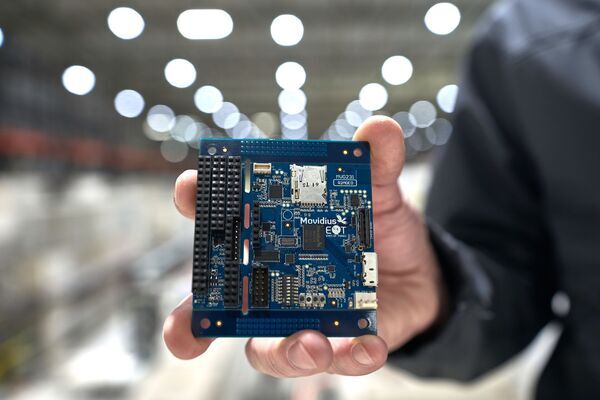
FSSCat/Ф-sat-1 ready for launch
"The first artificial intelligence to be carried onboard a European Earth observation mission will be launched this week from Europe’s spaceport in Kourou, French Guiana. The pioneering artificial intelligence technology named ɸ-sat-1, pronounced PhiSat-1, will be the first experiment to improve the efficiency of sending vast quantities of data back to Earth. Earth-observing satellites are delivering a wealth of data on a daily basis, not only to understand how our planet works, but also for use in a myriad of practical applications to improve our lives. With today’s need to understand, monitor and address the current climate crisis, the demand for efficient data is more essential than ever. As part of the drive to foster innovation and new technology, ESA has worked alongside its partners to develop ɸ-sat-1 – Europe’s first artificial intelligence Earth observation mission – which will demonstrate how satellite data, coupled with digital technologies, can bring benefits to business, industry and science. ɸ-sat-1 will acquire an enormous number of images that will allow scientists to monitor changes in vegetation and water quality, detect urban heat islands and carry out experiments on the role of evapotranspiration in climate change." [...]
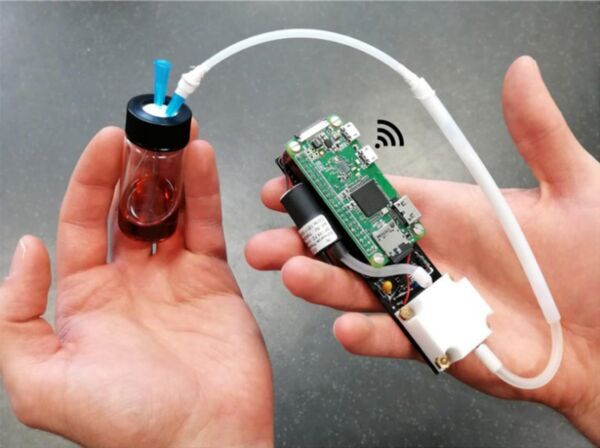
A portable methanol detector
"ETH researchers at the Department of Mechanical and Process Engineering have developed a device that detects low concentrations of methanol in alcoholic beverages. The results are displayed on a smartphone wirelessly in real time. Methanol can be lethal, even if it only occurs in small amounts. In 2019, at least 789 people who consumed alcoholic beverages contaminated with methanol died – mostly in Asia. The chemical is formed naturally when pectin is broken down during fermentation. However, the drinks are often deliberately adulterated with cheap methanol to increase profit and potency." [...]
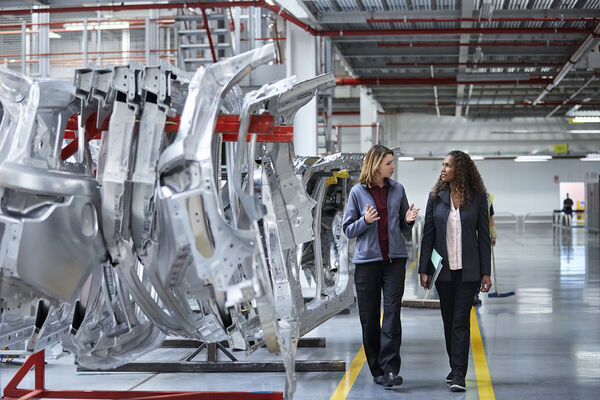
New technique for polymer manufacturing with reduced solvents aimed at vehicle, packaging production
"A team of Purdue University innovators hopes its new technology provides a more business-friendly option to utilize sustainable cellulose nanomaterials for use in vehicles, food packaging and other manufactured items. The Purdue team developed a new way for manufacturers to use nanocellulose – a green nanomaterial derived from natural sources such as plant matter. Normally to process nanocellulose, solvents or other dispersants are usually added to the mixture to improve the material’s dispersion in polymers. “These methods can be very expensive for manufacturers, who must add additional processes and machinery to comply with emission standards that may be impacted by the use of the solvents,” said Jeffrey Youngblood, a professor of materials engineering in Purdue’s College of Engineering. The Purdue innovators created a method that involves mixing the nanocellulose in additives for the polymer material, such as plasticizer, and then compounding that mixture into the polymer instead of directly mixing them. This technique could be applicable to a wide variety of polymers, including nylons used in the automotive industry and polylactic acid and ethylene vinyl alcohol copolymer used in food packaging." [...]

Quantum Physics: Long-range Satellite-based Secure Communications
"The exchange of a ‘secret key’ for encrypting and decrypting messages over a distance of 1,120 kilometres is reported in Nature this week. This achievement is made using entanglement-based quantum key distribution, a theoretically secure communication technique. Previous attempts to directly distribute quantum keys between two ground users under real-world conditions have reached distances of only around 100 kilometres. Quantum communication uses photons to securely distribute a ‘secret key’ to allow the exchange of encrypted messages. Previous work has demonstrated quantum key distribution along up to 404 kilometres of coiled optical fibre in a laboratory, or from a satellite to a ground station up to 1,200 kilometres away. However, real-world application between two users has been limited to around 100 kilometres." [...]
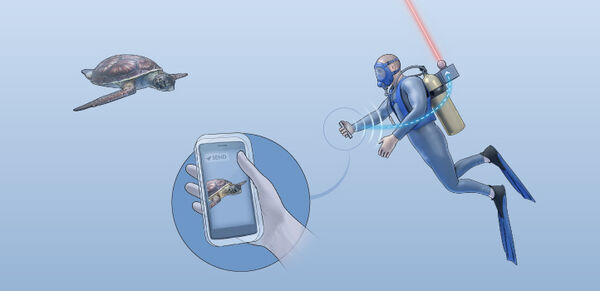
Angling for underwater WiFi
"Scuba divers could send sea life shots in real time using an aquatic internet service. Aquatic internet that sends data through light beams could enable divers to instantly transmit footage from under the sea to the surface. The internet is an indispensable communication tool, connecting tens of billions of devices worldwide, and yet we struggle to connect to the web from under water. “People from both academia and industry want to monitor and explore underwater environments in detail,” explains the first author, Basem Shihada. Wireless internet under the sea would enable divers to talk without hand signals and send live data to the surface. Underwater communication is possible with radio, acoustic and visible light signals." [...]

Scientists Detect Unexpected Widespread Structures Near Earth’s Core
"University of Maryland researchers conduct first simultaneous analysis of hundreds of earthquakes to identify echoes from features deep inside Earth University of Maryland geophysicists analyzed thousands of recordings of seismic waves, sound waves traveling through the Earth, to identify echoes from the boundary between Earth’s molten core and the solid mantle layer above it. The echoes revealed more widespread, heterogenous structures—areas of unusually dense, hot rock—at the core-mantle boundary than previously known. Scientists are unsure of the composition of these structures, and previous studies have provided only a limited view of them. Better understanding their shape and extent can help reveal the geologic processes happening deep inside Earth. This knowledge may provide clues to the workings of plate tectonics and the evolution of our planet. The new research provides the first comprehensive view of the core-mantle boundary over a wide area with such detailed resolution." [...]

Roller Grasper V2
"The ability to perform in-hand manipulation still remains an unsolved problem; having this capability would allow robots to perform sophisticated tasks requiring repositioning and reorienting of grasped objects. In this work, we present a novel non-anthropomorphic robot grasper with the ability to manipulate objects by means of active surfaces at the fingertips. Active surfaces are achieved by spherical rolling finger tips with two degrees of freedom (DoF) – a pivoting motion for surface reorientation – and a continuous rolling motion for moving the object. A further DoF is in the base of each finger, allowing the fingers to grasp objects over a range of size and shapes. Instantaneous kinematics was derived and objects were successfully manipulated both with a custom hard- coded control scheme as well as one learned through imitation learning, in simulation and experimentally on the hardware. " [...]
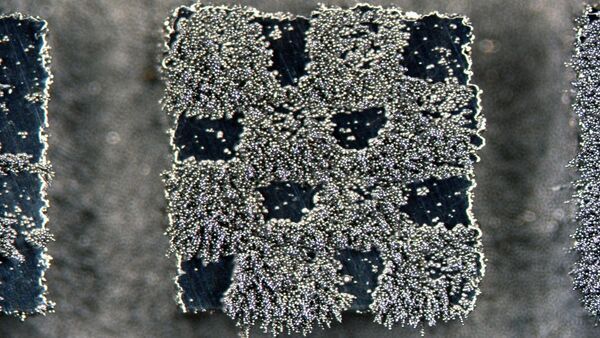
Freshly printed magnets
"During metal processing in the 3D laser printer, temperatures of more than 2,500 degrees Celsius are reached within milliseconds, causing some components of the alloys to evaporate. While widely considered a problem inherent to the process, Empa researchers spotted an opportunity – and are now using the effect to create new alloys with novel properties and embed them in 3D-printed metallic work pieces with micrometer precision. It looks quite inconspicuous to the casual beholder, hardly like groundbreaking innovation: a small metallic chessboard, four millimeters long on either side. At first glance, it shines like polished steel; at second glance, minute differences in color are visible: The tiny chessboard has 16 squares, eight appear slightly darker, the other eight a bit lighter. The unassuming material sample goes to show that 3D printing with the help of laser beams and metal pow-der is not only suitable for creating new geometric shapes, but also for producing new materials with completely new functionalities. The small chessboard is a particularly obvious example: Eight squares are magnetic, eight non-magnetic – the entire piece has been 3D-printed from a single grade of metal powder." [...]

Melting a crystal topologically
"Physicists at EPFL have successfully melted a very thin crystal of magnetic quasi-particles controllably, as turning ice into water. Novel phases of matter have been discovered and a new model system for fundamental physics studies has been established. The introduction of topology, a branch of mathematics focusing on the properties of “knots”, into physics has inspired revolutionary concepts such as topological phases of matter and topological phase transitions, which results in the Nobel Prize in Physics in 2016. Magnetic skyrmions, spin “nano-tornados” named after particle physicist T. Skyrme with unique topology (i.e. winding configurations, Fig. 1), have been attracting sharply increasing attentions in the last decade due both to their importance in fundamental physics and their promising applications in the next generation magnetic storage." [...]
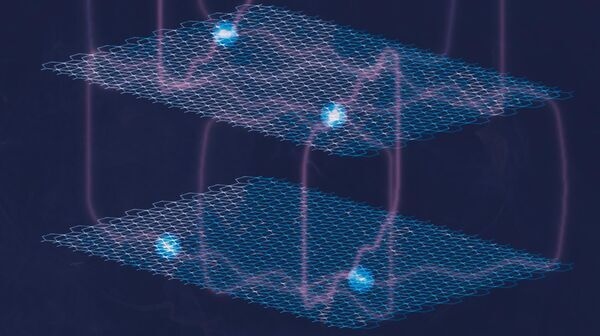
A surprising quantum effect observed in a “large” object
"While conducting experiments on a layered metal, EPFL researchers witnessed something very surprising. The unexpected electron behavior they discovered could open up possibilities in the field of quantum computing. In the world of materials science, sometimes main discoveries can be found in unexpected places. While working on the resistivity of a type of delafossite – PdCoO2 – researchers at EPFL’s Laboratory of Quantum Materials discovered that the electrons in their sample did not behave entirely as expected. When a magnetic field was applied, the electrons retained signatures of their wave-like nature, which could be observed even under relatively high temperature conditions and appeared in relatively large sizes. These surprising results, obtained in collaboration with several research institutions*, could prove useful, for example in the quest for quantum computing." [...]
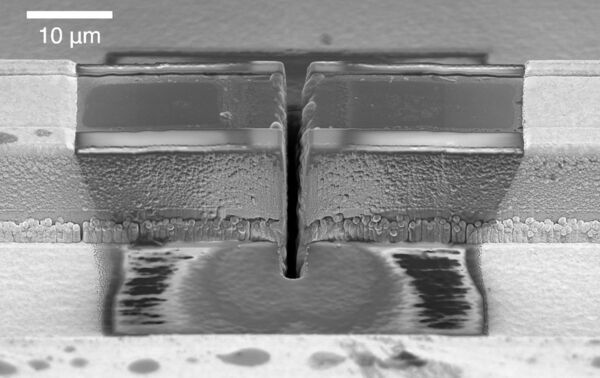
Order from disorder
"Using turbulence to generate frequency combs from small ring lasers We’ve all experienced turbulent air and water, but did you know light can be turbulent too? An international team of researchers, led by Federico Capasso, the Robert L. Wallace Professor of Applied Physics and Vinton Hayes Senior Research Fellow in Electrical Engineering at the Harvard John A. Paulson School of Engineering and Applied Sciences (SEAS), have harnessed turbulence in light to create a specific type of high-precision laser, known as a laser frequency comb, in a system previously thought incapable of producing such a laser. The discovery could be used in a new generation of devices for applications such as optical spectroscopy and sensing. The research is published in Nature. Frequency combs are widely-used tools for detecting and measuring different frequencies of light with unique precision. Unlike conventional lasers, which emit a single frequency, these lasers emit multiple frequencies in lockstep, evenly spaced to resemble the teeth of a comb." [...]
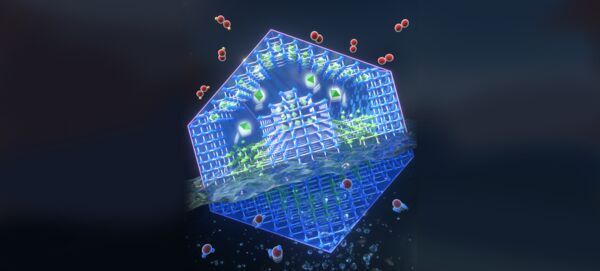
Energy Storage Using Oxygen to Boost Battery Performance
"Researchers have presented a novel electrode material for advanced energy storage device that is directly charged with oxygen from the air. Professor Jeung Ku Kang’s team synthesized and preserved the sub-nanometric particles of atomic cluster sizes at high mass loadings within metal-organic frameworks (MOF) by controlling the behavior of reactants at the molecular level. This new strategy ensures high performance for lithium-oxygen batteries, acclaimed as a next-generation energy storage technology and widely used in electric vehicles. Lithium-oxygen batteries in principle can generate ten times higher energy densities than conventional lithium-ion batteries, but they suffer from very poor cyclability. One of the methods to improve cycle stability is to reduce the overpotential of electrocatalysts in cathode electrodes. When the size of an electrocatalyst material is reduced to the atomic level, the increased surface energy leads to increased activity while significantly accelerating the material’s agglomeration." [...]

Astronomers detect regular rhythm of radio waves, with origins unknown
"Signal from 500 million light years away is the first periodic pattern of radio bursts detected. A team of astronomers, including researchers at MIT, has picked up on a curious, repeating rhythm of fast radio bursts emanating from an unknown source outside our galaxy, 500 million light years away. Fast radio bursts, or FRBs, are short, intense flashes of radio waves that are thought to be the product of small, distant, extremely dense objects, though exactly what those objects might be is a longstanding mystery in astrophysics. FRBs typically last a few milliseconds, during which time they can outshine entire galaxies. Since the first FRB was observed in 2007, astronomers have catalogued over 100 fast radio bursts from distant sources scattered across the universe, outside our own galaxy. For the most part, these detections were one-offs, flashing briefly before disappearing entirely." [...]
Projetos Maker
Diversos Projetos interessantes.
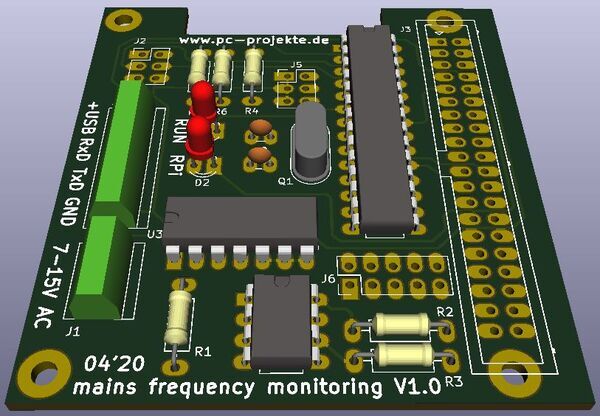
mains frequency measurement unit
"The circuit board presented here enables the exact mains frequency measurement of the power supply system (50 Hz and 60Hz). It is universally constructed and can be operated with a RaspberryPi 3/4 as well as with a USB-TTL converter. The output of the measurement data is done via the serial interface of the used ATMega328. The µC software is programmed with the Arduino IDE. The program can be easily extended or adapted. The reproduction is very simple." [...]
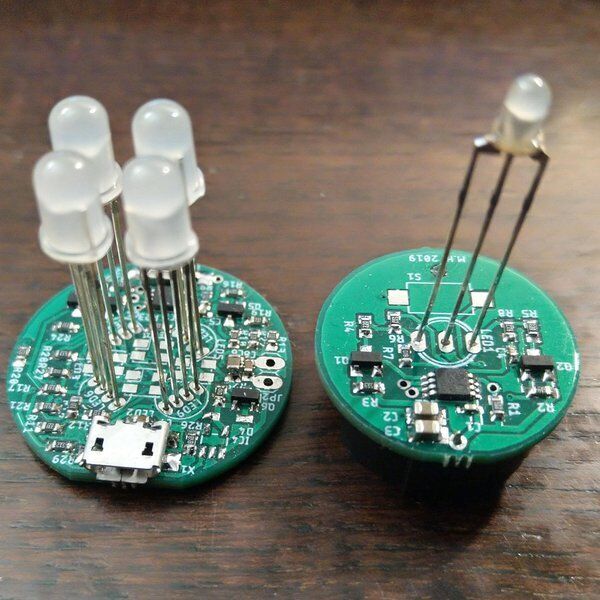
LED candles
"These candles flicker like a real candles and can be activated with real flame Flame (or heat) detection is based on temperature dependence of the LED's forward voltage. This voltage is measured (at very low LED current) by internal ADC of PIC12F1501. If the LED voltage under some predefined threshold for long enough time, LEDs are activated and start flickering. Big candle (with 4 LEDs) is powered by Li-Ion battery (yes, i know it's dangerous...) and is equipped with USB charger (MCP73831) and small one (with one LED) is powered by CR2032 or LIR2032. Small candle can be even put out with fingers. " [...]

Arduino Chandelier From Jars
"I wanted to give my room some special design, with mooth lighting so when I had the option to use RGB leds and a Arduino board I decided I needed my own making a chandelier. " [...]
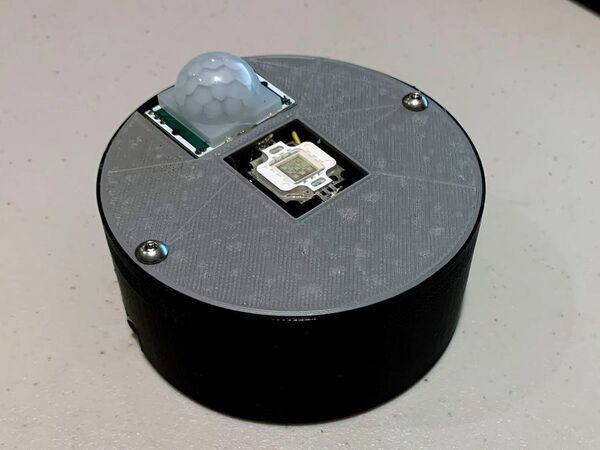
AutoSteri
"AutoSteri is a small and compact automatic UV sterilization system that uses a PIR to detect a human and cleans when they leave. The system uses a PIR sensor to detect the presence of a person and then after it detects the person leaving turns on a UVc LED for 15 minutes to disinfect the area where the person was. Applications: Sterilize package deliveries Sterilize elevators Sterilize hallways Sterilize offices etc. The Electronics Build (without PCB): Take your Arduino and place it on the centerline of your breadboard. Connect your power source connector, e.g. 5.5mm jack, to the VIN and GND pins of the Arduino." [...]

ASCII Video Terminal
"Geoff Graham released an inexpensive video terminal design in 2014. Several others have updated the firmware. Here is an updated PC board. Geoff Graham released an inexpensive video terminal design in 2014. Unfortunately the original design only had TTL serial output and it was necessary to add external drivers for RS232 levels. Several others have updated the firmware including allowing use of a USB keyboard." [...]

Inside the Am2901: AMD's 1970s bit-slice processor
"You're probably familiar with modern processors made by Advanced Micro Devices. But AMD's processors go back to 1975, when AMD introduced the Am2901. This chip was a type of processor called a bit-slice processor: each chip processed just 4 bits, but multiple chips were combined to produce a larger word size. This approach was used in the 1970s and 1980s to create a 16-bit, 36-bit, or 64-bit processor (for example), when the whole processor couldn't fit on a single fast chip. The Am2901 chip became very popular, used in diverse systems ranging from the Battlezone video game2 to the VAX-11/730 minicomputer, from the Xerox Star workstation to the F-16 fighter's Magic 372 computer.3 The fastest version of this processor, the Am2901C, used a logic family called emitter-coupled logic (ECL) for high performance. In this blog post, I open up an Am2901C chip, examine its die under a microscope, and explain the ECL circuits that made its arithmetic-logic unit work." [...]
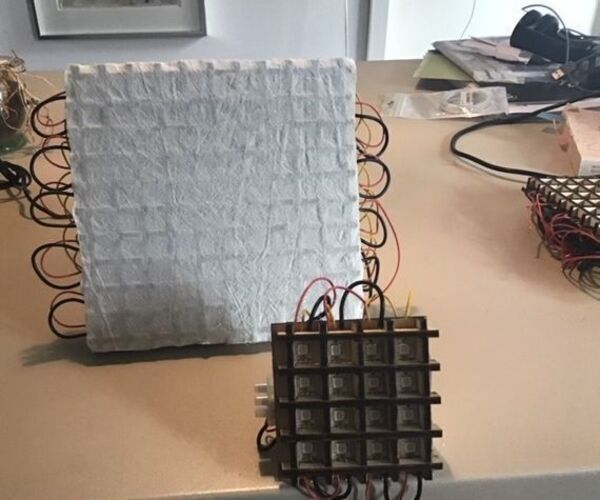
Micro:bit - LED Matrix
"In this guide I will go through how to build a LED matrix for the micro:bit out of LED strips. I will be using a 4x4 matrix and a 10x10 matrix as my examples. Since I work at a school, where we do a lot of building we would end going through a lot of battery holders, power supplies and micro:bit if everything had to be build into the project. On the other hand it doesn't look very good if you just connect the micro:bit with alligator connectors, so in this guide I will also show how we build things to be taken appart again. I have already made a short guide on how to program neopixels, but I will upload another guide latter with a bit more focus on how to program a neopixel matrix. Supplies:Materials: 4 mm plywood 1 x TO220-3 voltage regulator 2 x 10 uF electrolytic capasitor 1 x 5 volt power supply 2 A is enough for a 4x4 matrix, but you want 4 A for a 10x10 matrix 3 x M3 25 bolts 12 x M3 Nuts 1 x Micro:bit 1 x 330 ohm resistor 1 x Two way screw terminal block connector A strip of Micro:bit compatible neopixels." [...]
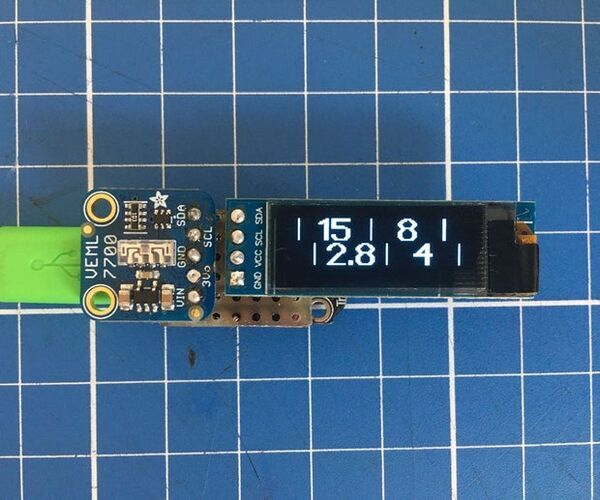
DIY Photographic Lightmeter
"This Instructable shares some ideas on building a simple small and cheap incident lightmeter. The goal for me was a light-meter to accompany my Bronica ETRSi medium format film camera. Things i wanted it to feature: single ASA (100) because i almost only use ASA 100 film as small as possible only give me combinations that my Bronica can reproduce, which means f2.8-f22 and 1sec to 1/500th sec no nonsense features, except plain times and aperture values Things i used: Adafruit(Vishay) VEML 7700 digital Lux-meter ( around 5$) Adafruit Trinket M0 micro controller (around 9$) 128x32 OLED display (around 10$) a pushbutton to temporarily turn it on (some cents) a tiny piece of strip-board, because i try to not use cables, but you can certainly use cables too" [...]
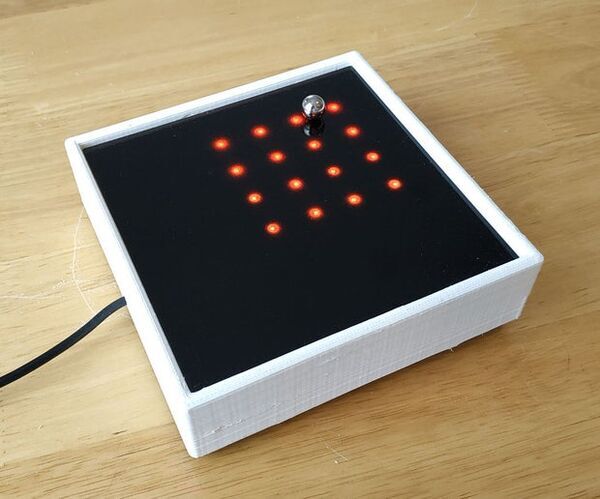
Arduino Magnetic Board
"My first meeting with microcontrollers was a few decades ago (you might remember the first Parallax Basic Stamps) but with the Arduino platform it happened more recently, only 6 years ago and although at that time the development boards were quite difficult to find, even then I found it was a very interesting thing. Later I bought a so-called 'electronic kit' with an original Arduino Uno, with LEDs, buttons, some sensors, relay, motor, infrared receiver and many other useful things :) My first installation was a button connected to the Arduino which lit one LED. Now everything has changed, Arduino has become very cheap, you can find a lot of copies on the Chinese market, the platform allows the connection of hundreds of kinds of sensors, hundreds of kinds of peripherals and with the help of libraries writing programs has become fast and easy. I have advanced quite a lot since the first installation (button plus led) and I would like to present to you in this article one of my last attempts. In this application the main role will belong to the reed switch. The simplest application of this magnetic sensor is like my first Arduino installment, the status of the reed switch is read by a digital input of an Arduino nano and a led (in this case the onboard led) lights up when we bring a magnet closer to the reed switch (see GIF below)." [...]
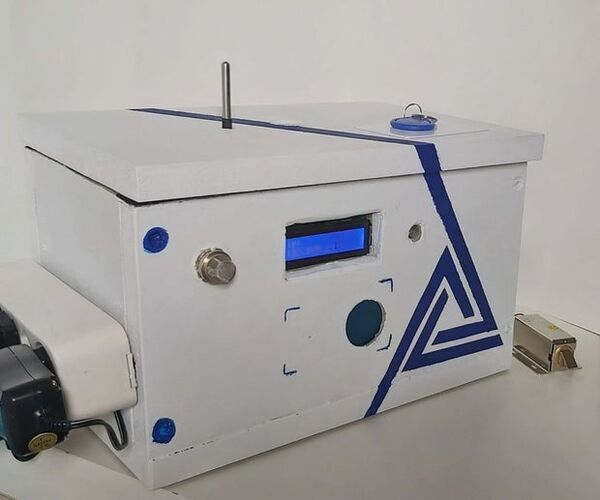
Electromagnetic Lock With Air Monitoring
"I've had this issue for a while where people seemingly don't value my privacy as much as i do myself and just barge into my room whenever they feel like it without any warning. So since i had this assignment coming up for my first year at MCT (a dutch course at Howest Kortrijk). I had chosen to make a lock that could be opened without getting up from my desk. A few weeks after deciding on this idea there was an accident where the house behind my dormitory caught fire, and whilst evacuating i thought of making this lock even more safe with a few buildt in sensors that would monitor the room temperature, humidity and air level. The lock would also get an RFID reader for an ease of access so that a person can quickly vacate the room in an emergency. So following that little intro, i will show you exactly how to build this lock step-by-step." [...]
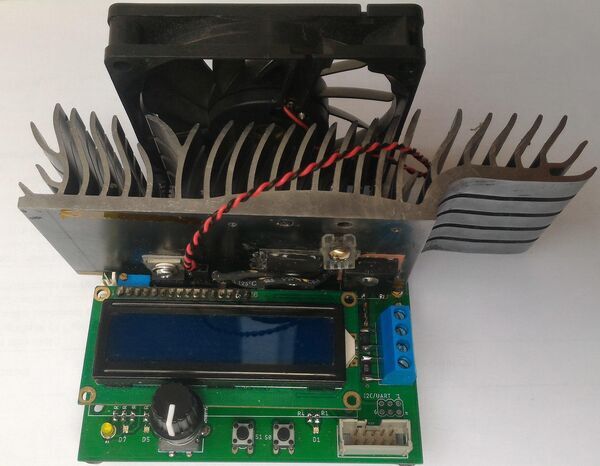
Electronic Load
"Features Constant Current, Power and Resistance modes Battery capacity logging with adjustable cutoff voltage Input and output power logging : instant efficiency reading for DC-DC converters Rotary encoder driven interface Dedicated Load ON/OFF button Intuitive LCD menu system with editable values 12bit current, voltage and power measurements 30W continuous sinking capability, 250W peak Temperature controlled fan with auto shutdown. Adjustable acquistion rate 115200 bauds serial communication through USB with a PC (non-isolated !) Specifications Enough talk, give us the specs, son ! Altough the device has not been fully qualified through systematic testing, here are the basic specs you can expect. Input voltage range : 0 - 100V DC maximum, 2-80V DC regulating Supply voltage range : 0 - 16V maximum, 12V nominal Device current consumption : 50mA nominal (0.6W) Load current range : 5mA - 5.25A, in 8mA steps Current regulation : 5% +/- 8mA typical @ 8kHz bandwidth Transient response : rise time < 20µs/A, overshoot < 2% Constant Power/Resistance regulation bandwidth : 10Hz Schematic and Layout The heart of the system is an Atmel ATmega328P AVR microcontroller with 32kB of Flash and 2k of RAM running at a whopping 16MHz. It interfaces an I2C 12bit DAC (the MCP47FEB21A1) and the LTC2992 dual power monitor chip." [...]
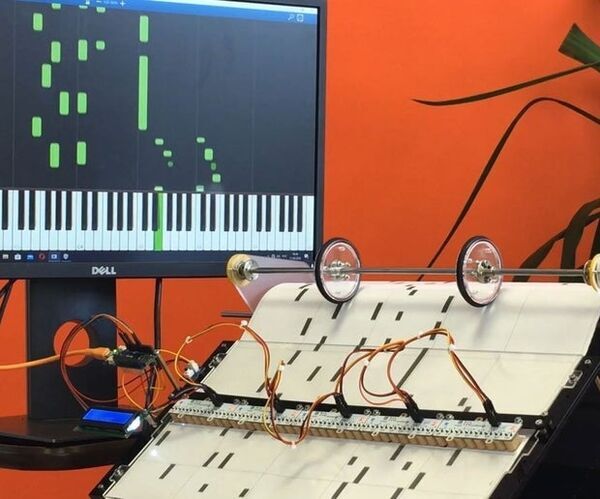
Arduino Barrel Piano
"Hello! That's the story of how I made my automatic barrel piano on the Arduino. This project was done exclusively for fun and does not imply the real use =) The idea of automatic musical instruments isn't new at all. People always tried to automate various musical instruments, including the piano. There were different automatic pianos from the mid-18th century until the invention of the gramophone, for example, a barrel piano (pic. 1), a player piano, also known as pianola (pic." [...]
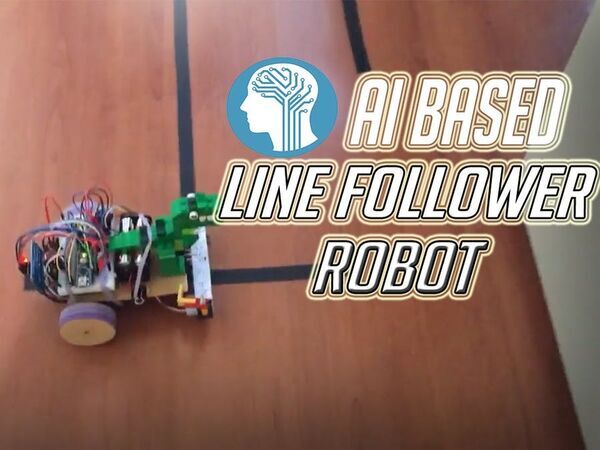
Artificial Intelligence (AI) Based Line Following Robot
"Artificial Intelligence (AI) based line Following robot is a robot that a sense of detecting the correct path for its route. After developing the Arduino based Pick & Place Robot the idea was to develop an Artificial Intelligent AI-based line following robot. Developing a simple line following robot was good for the beginner just what it needed to add some sort of infrared sensors instead of servo motors in my recent project. "The idea was to test my skills at advanced level". Although it was a difficult task some sort of online research helped me a lot. When comes to AI it's the recent technology that has the potential to change the world environment thus effective human life.A dream that can come true by putting intelligence to our robots to understand real-life problems and solve it accordingly, that dream can be only come true through Artificial Intelligence that's why everyone is talking about it." [...]

How to Make a Magic Mirror with Raspberry Pi
"If you follow the SparkFun Blog, you may have seen my post about my attempts to keep up with my family's ever changing schedule. With schooling and summer camps going online and both myself and my partner working from home... there's just too many virtual meetings to keep up with. An offhand comment about needing a "battle station" led to the Magic Mirror project. " [...]
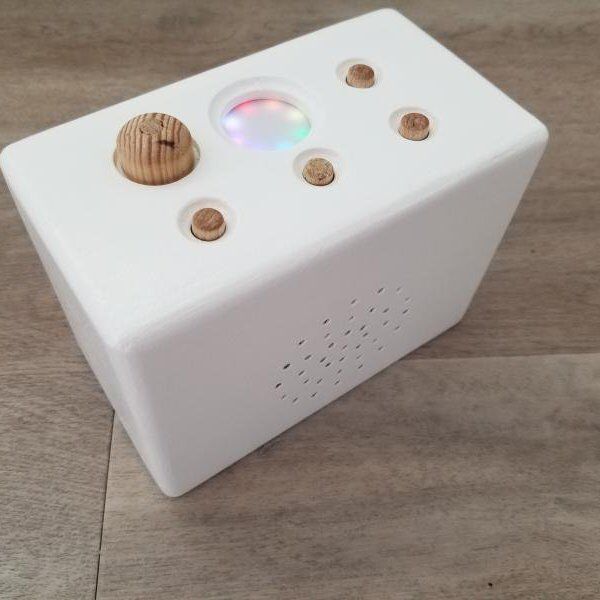
MP3Flower
"Mp3Flower is an MP3 player for small children from 2 to 5 years old. Mp3Flower is an MP3 player for small children from 2 to 5 years old. I present my work in a little details so that it can be useful to you. My son Quentin wanted me to make an MP3 player for his little boy Tom who is 2 and a half years old. It involves making available a large number of MP3s containing nursery rhymes, but also stories, music ... The devices that I saw on the internet did not satisfy me." [...]

Simple machine learning with Arduino KNN
"Machine learning (ML) algorithms come in all shapes and sizes, each with their own trade-offs. We continue our exploration of TinyML on Arduino with a look at the Arduino KNN library. In addition to powerful deep learning frameworks like TensorFlow for Arduino, there are also classical ML approaches suitable for smaller data sets on embedded devices that are useful and easy to understand — one of the simplest is KNN. One advantage of KNN is once the Arduino has some example data it is instantly ready to classify! We’ve released a new Arduino library so you can include KNN in your sketches quickly and easily, with no off-device training or additional tools required. In this article, we’ll take a look at KNN using the color classifier example." [...]

HV Nixie DC-DC Switching Power Supply using MAX1771
"Nixie tubes need about ~180Vdc to light up and thus on most devices, a DC-DC converter is needed. Here we designed a simple DC-DC switching regulator capable of powering most of Nixie tubes. The board accepts 12Vdc input and gives an output of 150-250Vdc. The module is based on the MAX1771 Step-Up DC-DC Controller. The controller works up to 300kHz switching frequency and that allows the usage of miniature surface mount components. In the default configuration, it accepts an input voltage from 2V to Vout and outputs 12V, but in this module, the output voltage is selected using the onboard potentiometer and it’s in the range 150-250Vdc.The MAX1771 is driving an external N-channel MOSFET (IRF740) and with the help of the inductor and a fast diode, high voltage is produced.MOSFET has to be low RDSon, the diode has to be fast Mttr, typically < 50nS, and capacitors have to be low ESR type to have good efficiency." [...]
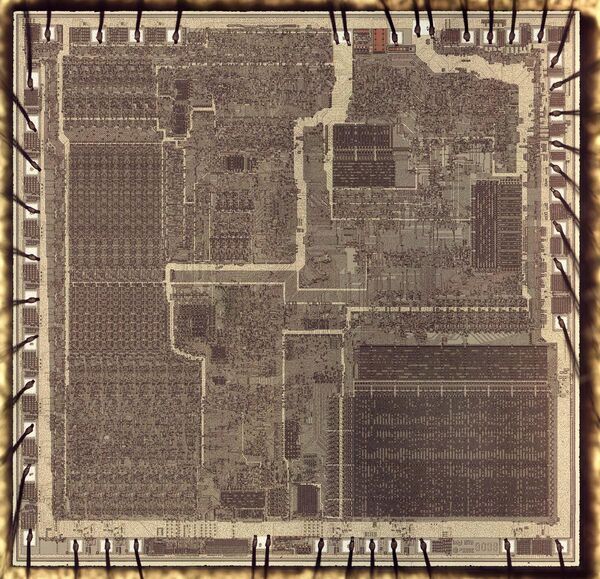
A look at the die of the 8086 processor
"The Intel 8086 microprocessor was introduced 42 years ago this month,1 so I made some high-res die photos of the chip to celebrate. The 8086 is one of the most influential chips ever created; it started the x86 architecture that still dominates desktop and server computing today. By looking at the chip's silicon, we can see the internal features of this chip. The photo below shows the die of the 8086. In this photo, the chip's metal layer is visible, mostly obscuring the silicon underneath. Around the edges of the die, thin bond wires provide connections between pads on the chip and the external pins." [...]
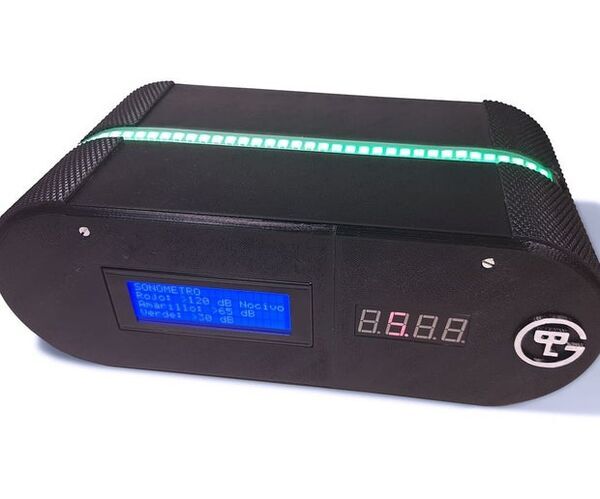
Sound Meter - Arduino
"In this Instructable I'll show how to make a Sound Meter using an Arduino and some more components. This is a school project I did recently which took me a year to complete, it is based on the construction of a Sound Meter which registers sound levels in decibels. The objective was highlighting noise pollution, a type of pollution that is less known, but which constantly affects us in our daily lives. Electronics: 1 - Arduino MEGA 2560 1 - SparkFun Sound Detector 1 - MicroSD Card Module 1 - Standard protoboard 1 - Neopixel LED Strip 1 - LCD (20X4) 1 - RTC DS3231(Real Tme Clock) 1 - Seven degment display 2 - 9V Batteries 1 - Buck Converter 12 - 220 Ω Resistor 1 - 470 Ω Resistor Cables 2 - Switches 1 - 1000 μF Capacitor 3D Printing: Anet A8 Bq Black PLA Assembly/tools: Hot glue + Hot glue gun Super Glue Screws --> 3mm x various lengths Double sided tape Soldering Iron + Heat-shrink tubes Screwdriver Electrical tape" [...]
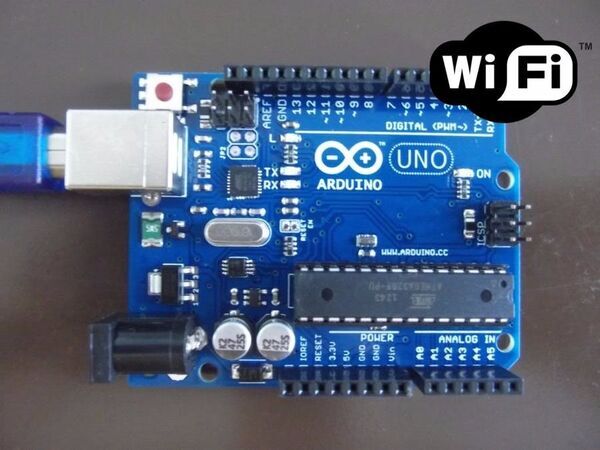
Add WiFi to Arduino UNO
"Connect your Arduino to the internet by adding ESP8266 WiFi Module! The ESP8266 Wifi module is a complete WiFi network where you can easily connect as a serving Wi- Fi adapter, wireless internet access interface to any microcontroller based design on its simple connectivity through Serial Communication or UART interface. Adding this module to your Arduino UNO will open you to more and exciting projects. What is the process? There are a lot of ways to use ESP866 for communication. Some may use it to send / receive data online or regularly upload data." [...]
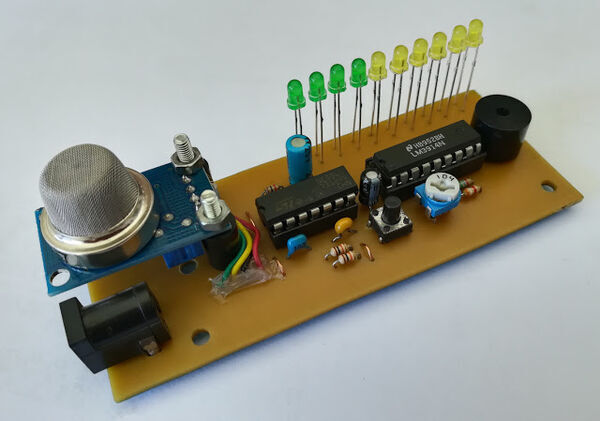
Low cost Carbon Monoxide meter
"Today Carbon Monoxide (CO) meters are available in different forms. Overall, Carbon Monoxide meters sense CO fast and display the amount to the user and trigger alarm if it reaches a critical level. Compare with most of the DIY Carbon Monoxide meters, the project which we described in this article does not need any development platform or MCU / firmware. The Carbon Monoxide meter in this project design around using general-purpose ICs, such as NE556 and LM3914. The main component of this meter is the FC-22 CO Gas sensor module. This module consists of the MQ-7 sensor and can use to detect CO gas concentrations, anywhere from 10 to 10,000ppm." [...]
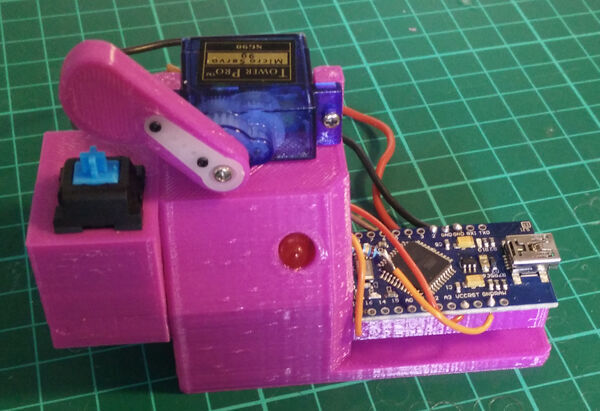
Automatic keyboard switch tester
"I'm working on designing an open source 3D-printable keyboard switch at the moment, with a view to eventually making my own mechanical keyboard using minimal off-the-shelf components (just an Arduino, wire, and diodes, with homemade parts for switches, keycaps, and case). I have not made a keyboard yet, but yesterday I made a device to test how many presses a switch can withstand before it stops working. How it works It uses a servo to turn a robotic finger that slowly presses the switch down. When it detects that the switch has closed, it lights up the LED and waits 100 ms for the contacts to settle, before slowly releasing the switch until it detects that the switch has opened again. At this point it switches off the LED, resets the servo to the start position, and writes the measured activation and deactivation positions to the PC over the USB serial connection. In the event that the servo reaches the configured end point without the switch closing, or reaches the configured start point without the switch opening, it logs a failure instead." [...]
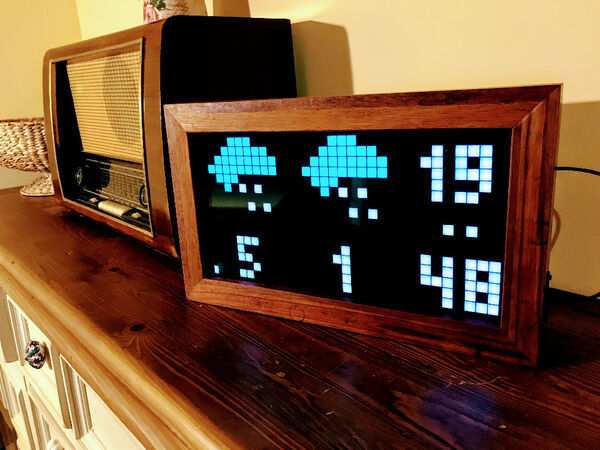
PxMatrix - LED matrix panel driver for ESP8266, ESP32 and ATMEL
"This driver controls Chinese RGB LED Matrix modules without any additional components whatsoever. Display structure The display basically consists of 6 large shift register. On the input connector you will find the inputs to the shift register (two for each color - Rx,Gx,Bx), a 2 to 5 bit latch address input (A,B,C,D,E), a latch enable input (LAT/STB), a clock input (CLK) and the output enable input (OE). There are a few basic row scanning layouts: 1/4, 1/8, 1/16 and 1/32 row scan. You can enable the correct pattern for your display with display.begin(n) where n={4,8,16,32} defines the pattern. For example, the 32x16 displays work like this (other varieties operate accordingly): Each of the shift register is 64(1/4 row scan) / 32(1/8 row scan) bits long." [...]

Building a Chaotic Oscillator from Common Components
"A chaotic oscillator is an electronic circuit that can exhibit “chaotic“, nonperiodic behavior. A commonly cited example is Chua’s circuit, but there are many others. I always regarded these as carefully designed, rather academic, examples. So I was a bit surprised to observe apparently chaotic behavior in a completely unrelated experiment. A while ago a took an interest in recreating an ancient logic style based on discrete transistors, resistor-transistor-logic (RTL), with todays components. I discussed some of my findings earlier and continued to work on transistor selection and circuit optimization afterwards in collaboration with Yann from Hackaday TTLers." [...]
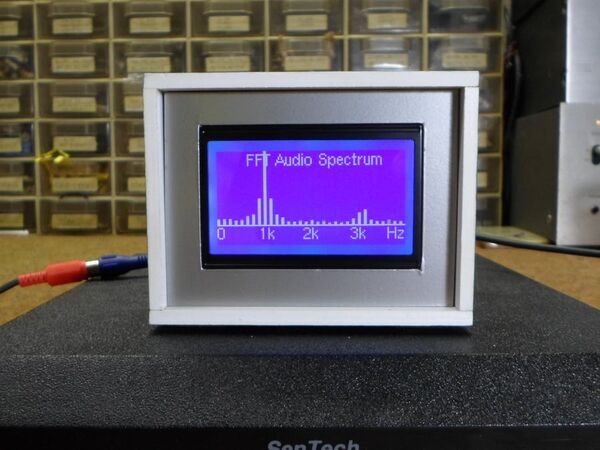
DIY FFT Audio Spectrum Analyzer
"FFT spectrum analyzer is a test equipment that uses Fourier analysis and digital signal processing techniques to provide spectrum analysis. FFT spectrum analyzer is a test equipment that uses Fourier analysis and digital signal processing techniques to provide spectrum analysis. Using Fourier analysis it is possible for one value in, for example, the continuous time domain to be converted into the continuous frequency domain, in which both magnitude and phase information are included. The described device is exactly such a Spectral Analyzer that is made with the help of an Arduino microcontroller. Аs you can see the device is very simple and contains only a few components : - Arduino Nano - LCD display with a resolution of 128 by 64 pixels (ST7920 128x64 LCD) - Two resistors (10KOhm) - Potentiometer (10KOhm) and - Capacitor (1 microF) The audio input to the Arduino is on A0, with bias at the mid point by 10K to Ground and 10K to +5V. At the input we can also set a potentiometer to control the amplitude of the input signal." [...]

Playing MP3’s (and other types) on your ESP32 from an SD Card
"How to play MP3’s and other file formats on your ESP32 from an SD Card. All you need to know to make a simple music player. Code shown in video is below. " [...]

Arduino Time Adjustable Relay Project
"Would you like to control a device by entering the time information? Arduino Time Adjustable Relay Project In this project, we enter the minutes and seconds data with the buttons. We press the run button and the relay changes position.The device connected to the output of the relay is working. The minutes and seconds count down values. When it is zero, the device at the output of the relay stops.You can add new features to the project. " [...]
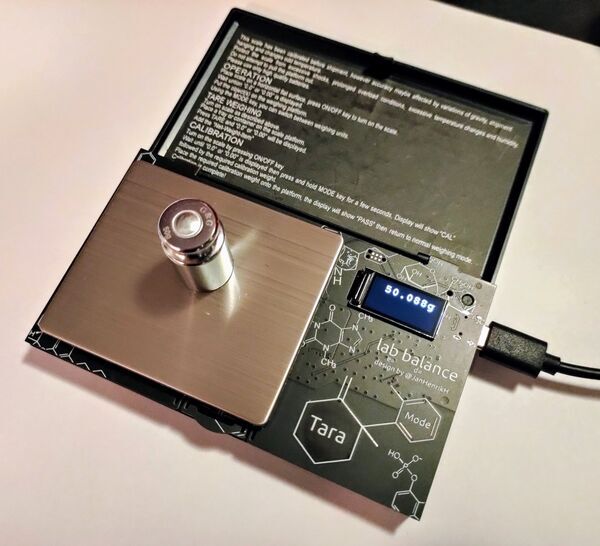
lab-balance
"This project aims to replace the electronics contained within a cheap scale from AliExpress to archive a higher resolution and hackability. Furthermore I need a scale which does not turn off after 30 seconds of use! The goal is not met so far, as the accuracy of the load cell is not sufficient for this task. It can be replaced with a higher end model. " [...]
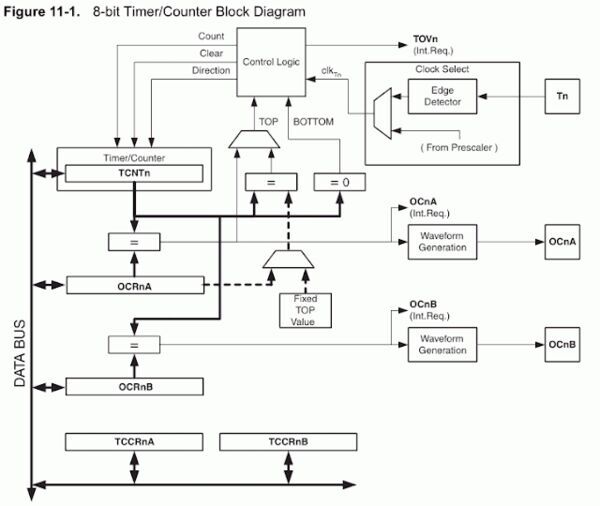
A full-duplex tiny AVR software UART
"I've written a few software UARTs for AVR MCUs. All of them have bit-banged the output, using cycle-counted assembler busy loops to time the output of each bit. The code requires interrupts to be disabled to ensure accurate timing between bits. This makes it impossible to receive data at the same time as it is being transmitted, and therefore the bit-banged implementations have been half-duplex. By using the waveform generator of the timer/counter in many AVR MCUs, I've found a way to implement a full-duplex UART, which can simultaneously send and receive at up to 115kbps when the MCU is clocked at 8Mhz. I expect most AVR developers are familiar with using PWM, where the output pin is toggled at a given duty cycle, independent of the code execution." [...]

Barcode Scanner for Bring! Shopping List
"This project aims to create a gadget that reads the 2D barcodes of the products I want to add to my shopping list. (Bring! Shopping List App). The gadget is built with an M5StickC + a 2D barcode reader with a serial port (YK-E1005-OEM) + a box built with a 3D printer to integrate them. To communicate with the Bring! application I took advantage of my Raspberry PI running Home Assistant." [...]
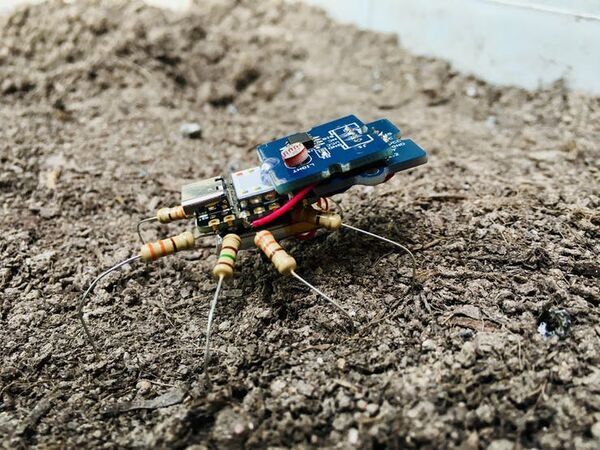
Runaway Spider
"This spider will keep quiet in the night. But once there is light, the spider will start to vibrate, avoiding the light. Story Spider-Man is my favorite Marvel hero, and for a long time, I fantasized about having a super-powerful little spider inadvertently bite me, which was simply awesome. Is this little spider cool? Because I want to be a small spider, I chose Seeeduino XIAO. With the cooperation of the vibration motor and light sensor, this spider will keep quiet in the night." [...]
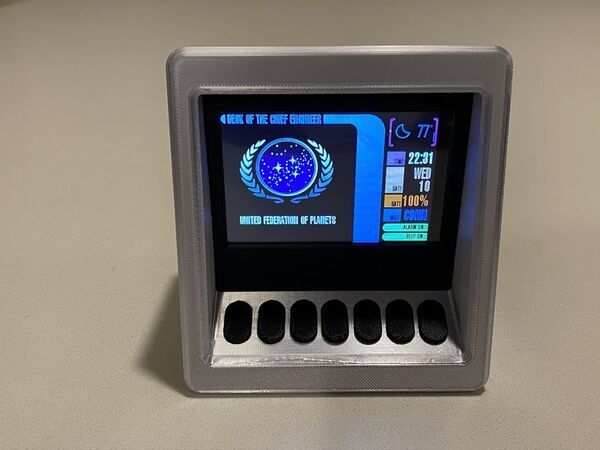
Make It So! Star Trek TNG Mini Engineering Computer
"This is a working display based on Star Trek TNG. Uses APIs and sensors for weather, VOCs, power measurement, calendar, fitness, and news. Overview I grew up watching Star Trek: The Next Generation. I've always wanted to build a Star Trek themed device, so I finally got around to remixing one of my old projects to make a Star Trek Display Terminal. The terminal provides the following information: Weather - using the National Weather Service Indoor Temperature, Humidity and Volatile Organic Compound (VOC) strength News Articles - from News.org Schedule (with alarm function) - from Microsoft Outlook Fitness Information (Steps, Move Minutes, Heart Points, Weight, Calories Burned) - from Google Fitness a Resistor color code chart an LED Resistor Calculator (to determine the resistor value based on current and source power) Power and Current Measurement tool This information is made available through a combination of APIs and hardware sensors. I leverage an ESP32 for the microcontroller, and leverage the AWS Cloud for all of the data collection and aggregation." [...]
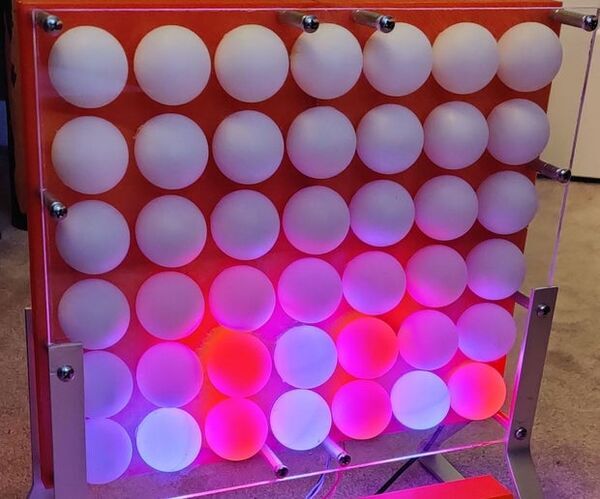
Electronic Connect Four (arduino)
"Authors: Kelly Bodeman - [email protected] Jack Whelan - [email protected] (For more questions contact us at our emails above) Here is a link of a youtube video of our project: Connect Four Video AcknowledgmentsCalifornia Maritime Academy (Marine Engineering Technology) Professor Chang-Siu (ET370 Electronics) The Idea: Connect Four is a two-player game typically consisting of a 7 x 6 board where players physically drop their chips into their desired slot. The goal of the game is to get four of your color in a row whether it be vertically, horizontally, or diagonally. Instead of physically dropping the chips into slots there are buttons that correspond to their nearest row. When the button is pressed the board will play an animation of a ball dropping. The color/player changes from blue and red every time a ball is dropped. The most challenging part of this project is detecting a win." [...]

DIY PCB Shaker (Low-Cost)
"Tired of spending half an hour shaking a vat of Ferric Chloride? Build your own DIY Low-Cost PCB Shaker! It's a very cheap and simple project that only requires common materials. The machine can reduce etching time of Ferric Chloride down to 10 minutes, depending on the speed and the etchant's concentration. The Problem: PCB fabrication requires etching. Ferric chloride is a common choice of enchant." [...]
That's all Folks!



